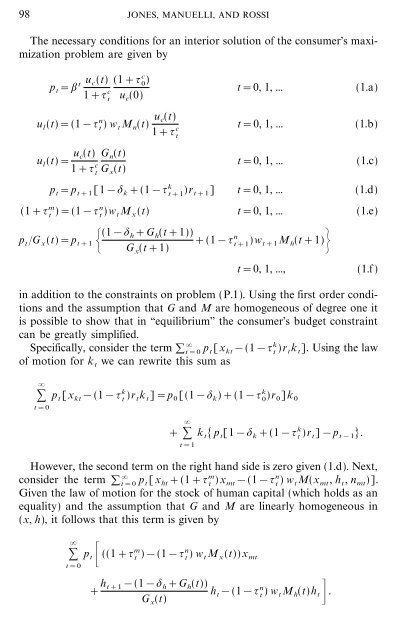On the Optimal Taxation of Capital Income
On the Optimal Taxation of Capital Income
On the Optimal Taxation of Capital Income
You also want an ePaper? Increase the reach of your titles
YUMPU automatically turns print PDFs into web optimized ePapers that Google loves.
98 JONES, MANUELLI, AND ROSSI<br />
The necessary conditions for an interior solution <strong>of</strong> <strong>the</strong> consumer's maximization<br />
problem are given by<br />
p t=; t u c(t)<br />
1+{ c<br />
t<br />
(1+{ c<br />
0 )<br />
u c(0)<br />
t=0, 1, ... (1.a)<br />
ul(t)=(1&{ n<br />
t ) wtMn(t) uc(t) 1+{ c<br />
t<br />
t=0, 1, ... (1.b)<br />
ul(t)= uc(t) 1+{ c<br />
Gn(t) t Gx(t) t=0, 1, ... (1.c)<br />
pt=p t+1[1&$ k+(1&{ k<br />
t+1 )rt+1] t=0, 1, ... (1.d)<br />
(1+{ m<br />
t )=(1&{n t )wtMx(t) t=0, 1, ... (1.e)<br />
pt Gx(t)=pt+1{ (1&$ h+Gh(t+1)) +(1&{<br />
Gx(t+1) n<br />
t+1 )wt+1Mh(t+1) =<br />
t=0, 1, ..., (1.f )<br />
in addition to <strong>the</strong> constraints on problem (P.1). Using <strong>the</strong> first order conditions<br />
and <strong>the</strong> assumption that G and M are homogeneous <strong>of</strong> degree one it<br />
is possible to show that in ``equilibrium'' <strong>the</strong> consumer's budget constraint<br />
can be greatly simplified.<br />
Specifically, consider <strong>the</strong> term t=0 p t[x kt&(1&{ k<br />
t )r tk t]. Using <strong>the</strong> law<br />
<strong>of</strong> motion for k t we can rewrite this sum as<br />
:<br />
t=0<br />
p t[x kt&(1&{ k<br />
t )r tk t]=p 0[(1&$ k)+(1&{ k<br />
0 )r 0]k 0<br />
+ :<br />
t=1<br />
k t[p t[1&$ k+(1&{ k<br />
t )r t]&p t&1].<br />
However, <strong>the</strong> second term on <strong>the</strong> right hand side is zero given (1.d). Next,<br />
consider <strong>the</strong> term t=0 pt[xht+(1+{ m<br />
t )xmt&(1&{ n<br />
t ) wtM(xmt, ht, nmt)]. Given <strong>the</strong> law <strong>of</strong> motion for <strong>the</strong> stock <strong>of</strong> human capital (which holds as an<br />
equality) and <strong>the</strong> assumption that G and M are linearly homogeneous in<br />
(x, h), it follows that this term is given by<br />
:<br />
t=0<br />
p t_ ((1+{m<br />
t )&(1&{n<br />
t ) w tM x(t))x mt<br />
+ h t+1&(1&$ h+G h(t))<br />
G x(t)<br />
h t&(1&{ n<br />
t ) w tM h(t)h t& .
















